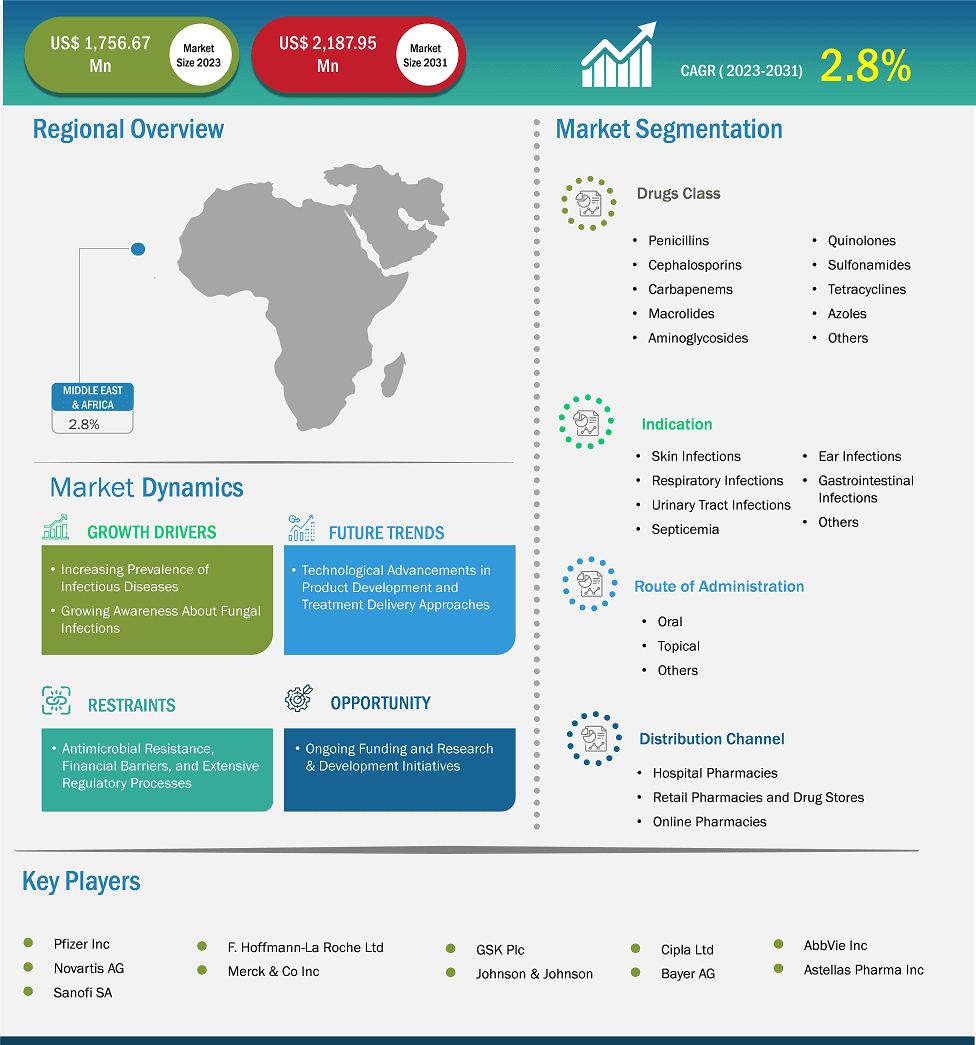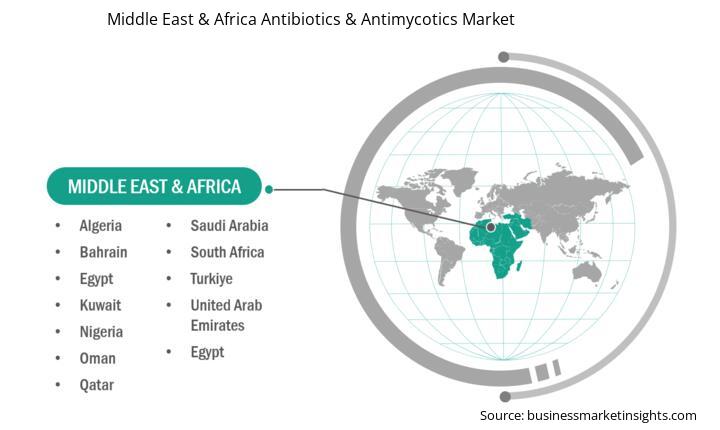Middle East & Africa Antibiotics & Antimycotics Market Report (2021-2031) by Scope, Segmentation, Dynamics, and Competitive Analysis
No. of Pages: 187 | Report Code: BMIRE00032107 | Category: Life Sciences
No. of Pages: 187 | Report Code: BMIRE00032107 | Category: Life Sciences
The Middle East & Africa antibiotics & antimycotics market size is expected to reach US$ 2,187.95 million by 2031 from US$ 1,756.67 million in 2023. The market is estimated to record a CAGR of 2.8% from 2023 to 2031.
The Middle East & Africa antibiotics and antimycotics market is segmented into Saudi Arabia, South Africa, UAE, and the Rest of Middle East & Africa. The major factors driving the market are the increasing prevalence of infectious diseases caused by bacteria and fungi; strategic initiatives by market players such as new product launches, partnerships, collaborations, and product developments; and favorable government initiatives. Further, geographical expansion by the market players and surging awareness about the proper use of antibiotics and antimycotics are a few factors expected to fuel the market growth in the coming years.
Middle East & Africa Antibiotics & Antimycotics Market Strategic Insights

Middle East & Africa Antibiotics & Antimycotics Market Segmentation Analysis
Key segments that contributed to the derivation of the Middle East & Africa antibiotics & antimycotics market analysis are drug class, indication, route of administration, and distribution channel.
Infectious diseases are caused by bacteria, viruses, parasites, fungi, and toxic substances. As per ReAct Group 2022 report, there were 77 million deaths reported globally linked to bacterial infection excluding tuberculosis, which accounts for 13.6% of total deaths globally. According to the World Health Organization (WHO), tuberculosis (TB) ranks 13th among the most common causes of death and 2nd among the most frequent infectious diseases, after COVID-19, globally. As per WHO data, 1.3 million people (including 214,000 people affected by HIV) succumbed to TB in 2022. Its estimations also state that 10.6 million people in the world had TB in 2022, including 1.3 million children, 3.5 million women, and 5.8 million men. 30 countries with high TB burdens accounted for 86–90% of new TB cases that year. Eight countries comprised two-thirds of the total, with India leading the way, followed by the Philippines, China, Indonesia, Pakistan, Nigeria, Bangladesh, and South Africa.
Hospital-acquired infections or healthcare-associated infections (HAIs) have high morbidity and mortality rates. They cost healthcare systems hefty amounts every year. Patients suffering from hospital-acquired diarrhea are treated using metronidazole and vancomycin, among other antibiotics. Ofloxacin, ceftriaxone, and amoxicillin/co-amoxiclav are the commonly prescribed antibiotics against urinary tract infections.
Furthermore, increasing fungal infections are one of major concerns among large population globally affecting millions. According to the Global Action Fund for Fungal Infections (GAFFI) 2024, every year more than 80 million people are at high risk of developing fungal disease and approximately 6.55 million patients develop life-threatening fungal infections annually, of which 3.75 million people die. Azoles and Amphotericin B are some of the common antimycotics sued for the treatment of fungal infections globally. Thus, the rising prevalence of various bacteria and fungi associated infectious diseases across the world creates a significant need for antibiotics and antimycotics.
Based on country, the Middle East & Africa antibiotics & antimycotics market comprises Saudi Arabia, South Africa, the UAE, and the Rest of Middle East & Africa. Saudi Arabia held the largest share in 2023.
The antibiotics and antimycotics market in Saudi Arabia is driven by surging healthcare expenditures and a rising prevalence of infectious diseases, followed by ongoing health initiatives and rising awareness of antibiotic resistance. According to the BMC Infectious Disease Journal 2023, UTI is the most common renal infection, which can lead to various renal complications, accounting for 10% of all infections recorded in Saudi Arabia. As per the Journal of Epidemiology and Global Health 2024 Journal, the prevalence of tuberculosis in the country is 17%, which is higher than the global average of 12%. Penicillin is the most commonly used antibiotic drug class for the treatment and management of bacterial infections. Moreover, increasing product launches and developments are expected to create ample opportunities for market growth in the coming years. For instance, in October 2023, Biocomposites launched STIMULAN in Saudi Arabia. It is an antibiotic carrier that can be used in wound healing and treatment of bacterial infections in soft tissue surrounding bone.
Middle East & Africa Antibiotics & Antimycotics Market Report Highlights
Report Attribute
Details
Market size in 2023
US$ 1,756.67 Million
Market Size by 2031
US$ 2,187.95 Million
CAGR (2023 - 2031) 2.8%
Historical Data
2021-2022
Forecast period
2024-2031
Segments Covered
By Drug Class
By Indication
By Route Of Administration
By Distribution Channel
Regions and Countries Covered
Middle East and Africa
Market leaders and key company profiles
Middle East & Africa Antibiotics & Antimycotics Market Company Profiles
Some of the key players operating in the market are Pfizer Inc, Novartis AG, Sanofi SA, F. Hoffmann-La Roche Ltd, Merck & Co Inc, GSK Plc, Johnson & Johnson, Cipla Ltd, Bayer AG, AbbVie Inc, and Astellas Pharma Inc, among others. These players are adopting various strategies such as expansion, product innovation, and mergers and acquisitions to provide innovative products to their consumers and increase their market share.
The following methodology has been followed for the collection and analysis of data presented in this report:
The research process begins with comprehensive secondary research, utilizing both internal and external sources to gather qualitative and quantitative data for each market. Commonly referenced secondary research sources include, but are not limited to:
Note: All financial data included in the Company Profiles section has been standardized to USD. For companies reporting in other currencies, figures have been converted to USD using the relevant exchange rates for the corresponding year.
The Insight Partners conducts a significant number of primary interviews each year with industry stakeholders and experts to validate its data analysis and gain valuable insights. These research interviews are designed to:
Primary research is conducted via email interactions and telephone interviews, encompassing various markets, categories, segments, and sub-segments across different regions. Participants typically include:

The Middle East & Africa Antibiotics & Antimycotics Market is valued at US$ 1,756.67 Million in 2023, it is projected to reach US$ 2,187.95 Million by 2031.
As per our report Middle East & Africa Antibiotics & Antimycotics Market, the market size is valued at US$ 1,756.67 Million in 2023, projecting it to reach US$ 2,187.95 Million by 2031. This translates to a CAGR of approximately 2.8% during the forecast period.
The Middle East & Africa Antibiotics & Antimycotics Market report typically cover these key segments-
The historic period, base year, and forecast period can vary slightly depending on the specific market research report. However, for the Middle East & Africa Antibiotics & Antimycotics Market report:
The Middle East & Africa Antibiotics & Antimycotics Market is populated by several key players, each contributing to its growth and innovation. Some of the major players include:
The Middle East & Africa Antibiotics & Antimycotics Market report is valuable for diverse stakeholders, including:
Essentially, anyone involved in or considering involvement in the Middle East & Africa Antibiotics & Antimycotics Market value chain can benefit from the information contained in a comprehensive market report.